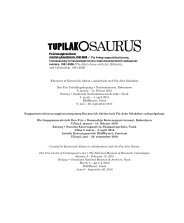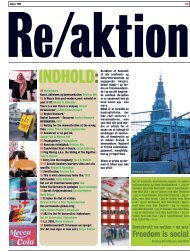tupilakosaurus - Print matters!
tupilakosaurus - Print matters!
tupilakosaurus - Print matters!
Create successful ePaper yourself
Turn your PDF publications into a flip-book with our unique Google optimized e-Paper software.
Assit, inulerneqarnerat<br />
nunap assiliornerlu. 2003<br />
paasisaminik ingerlatitseqqinnissaminik<br />
piginnaaneqarneranik.<br />
Arke nammineq inuit taama nuutsitaanerannit<br />
pilersitaavoq, naak sarfaq majoraluarlugu.<br />
Meeraanermini Kalaallit<br />
Nunaanni arlalinni najugaqarsimavoq<br />
inoqarfissuarmilu Danmarkimi. Taamaattumik<br />
atuagaq qamuunavik misigisaajutigaluni<br />
nuannersunik oqaluttuarpoq,<br />
atuakkiorfigineqartoq inummit<br />
pisunik siullermeerluni takunnillunilu<br />
tusagalimmit, arlaatigut takorlooreersimasaminik,taamaattussaasinnaasutut<br />
misigisimasaminik. Takusaminik<br />
allaatigisai inuttut paasinninneranik<br />
tupigusunneranillu ulikkaarput. Qularnanngitsumik<br />
isumassuinerup ersoqatiginninnerullu<br />
akornanni, soorlu Arkep<br />
oqaluttuarigaangagit assigiinngitsunik<br />
nagguillit aappariilerneri meerariligaallu,<br />
aappaatigullu aamma quianartumik<br />
isornartorsiuinertalimmillu. Atuakkap<br />
saqqaata assitaa takuinnaruk!<br />
Ittoqqortoormiit tassaavoq “suitsoq”: eqqaamasaqarfiunngilaq,<br />
itsaq pisimasunik<br />
oqaluttuaqanngilaq, eqqaamasassartaqanngilaq,<br />
iluatsitsisimanngilaq.<br />
Tamanna “suinneq” unammillerlugu<br />
taalliatullusooq oqaluttuarnermini takinngikkaluami<br />
Arkep saqqummersikkusuppaa<br />
assilissat oqaluttuarineqartullu<br />
atorlugit. Oqaluttuamut tassunga<br />
Jonsson pingaarutilinnik ilanngussivoq<br />
sinaakkusiisumik allatamigullu<br />
– aamma sarmiilluni, imaluunniit<br />
“imarpissuarni pigisatsinnik” Danmarkip<br />
oqaluttuarinnittarnerata sarfaa<br />
majorlugu. Atuagaq una aqqutigalugu<br />
oqaluttuarujussuup isertuartumik akunniffia<br />
oqaluttuarineqarpoq, tamatumalu<br />
kingorna kalaallit danskilluunniit nunasiaataanerup<br />
nalaani peqatigiillutik<br />
atorsimasatik toqqortersinnaajunnaarpaat,<br />
1900-kkunni pisimasut, inuuneq<br />
pissaaneqarnerlu.<br />
Italiamiu eqqarsarnikkaaq Giorgio<br />
Agamben ungaserujussuanngitsukkut<br />
allappoq nunat killiit nunarsuullu sinnerata<br />
akornanni pissutsit paasiumagaanni<br />
uninngaarfii paasisariaqartut.<br />
Københavnip Nuullu akornanni tassunga<br />
assingusumik qitiusoqarpoq: Taanna<br />
ateqarpoq Ittoqqortoormiit.<br />
Carsten Juhl<br />
Pia Arke. Stories from Scoresbysund. Photographs,<br />
Colonisation and Mapping. 2003<br />
Pia Arke’s book Stories from<br />
Scoresbysund is a literary object<br />
that it is difficult to place in<br />
one particular genre. The book<br />
carries the subtitle Photographs,<br />
Colonisation and Mapping, and<br />
these are designations that are<br />
both precise and also a little too<br />
neutral. For the book first and<br />
foremost contains Arke’s personal<br />
attempt at finding a more or less<br />
coherent account of the genesis of<br />
a quite special place and the life<br />
lived there: the place is on Greenland’s<br />
east coast, and it was populated<br />
with hunter families from<br />
Angmassalik, but the purpose of<br />
establishing the settlement was<br />
Danish and conceived as a geopolitical<br />
solution to the question<br />
as to what country – Denmark or<br />
Norway – had “dominion” over<br />
the north-eastern part of Greenland.<br />
The Swedish writer and<br />
cultural critic Stefan Jonsson has<br />
therefore furnished the book with<br />
“cartographical sections” that<br />
describe the typical connection<br />
between voyages of exploration,<br />
anthropology, mapmaking and<br />
political objectives characteristic<br />
of a colonial power in the age of<br />
imperialism.<br />
The book is the result of a visual<br />
artist’s work, but instead of using<br />
her talent to create vivid depictions<br />
of an isolated settlement in<br />
a wilderness, Arke has allowed<br />
the isolated and distant to exhibit<br />
itself: the pictures are therefore<br />
– with the exception of a number<br />
of portraits – other people’s photographs,<br />
and the reader also has<br />
the opportunity to listen to many<br />
Greenlandic voices in the account<br />
of life in Scoresbysund (in East<br />
Greenlandic: Ittoqqortoormiit)<br />
over three generations. But the<br />
approach to the subject and the<br />
presentation of the many investigations<br />
Arke carried out during<br />
her study trips to Scoresbysund<br />
are all characterised by the ability<br />
of the impartial artist to pass<br />
on insights.<br />
Arke herself was a product of this<br />
transfer of population albeit in a<br />
cross-cutting way. As a child she<br />
had lived in a number of places in<br />
Greenland and in the metropole<br />
Denmark. The book is therefore<br />
both deeply empathic and cheerfully<br />
narrative, written by a person<br />
who sees and hears things for<br />
the first time as she had somehow<br />
imagined, felt that they might<br />
be. The observations form a text<br />
full of human understanding and<br />
wonder. Undoubtedly between<br />
care and solidarity as when Arke<br />
tells of the mixed marriages and<br />
the children who were born in<br />
them, but also between humour<br />
and criticism. Just look at the<br />
picture on the front cover of the<br />
book!<br />
Scoresbysund was a place “without”:<br />
without memory, without<br />
stories from the past, without<br />
recollections, without success.<br />
This “without” was the big challenge<br />
for the little epos that Arke<br />
sought to conjure up with the<br />
help of pictures and accounts.<br />
Jonsson provided the crucial<br />
framework and texture for this<br />
epos – again from the side, or<br />
cutting across the broader history<br />
of Denmark and “our overseas<br />
possessions”. This book illuminated<br />
the discreet centre of that<br />
broader history so that it is no<br />
longer possible for Greenlanders<br />
and Danes to repress the facts<br />
of their shared colonial past, the<br />
events, the life and the power, in<br />
the preceding century.<br />
The Italian philosopher Giorgio<br />
Agamben wrote recently that<br />
in order to understand relations<br />
between the West and the<br />
rest of the world, one must first<br />
understand the camps. Between<br />
Copenhagen and Godthåb there<br />
was a similar nexus: It was called<br />
Scoresbysund.<br />
Carsten Juhl<br />
59




